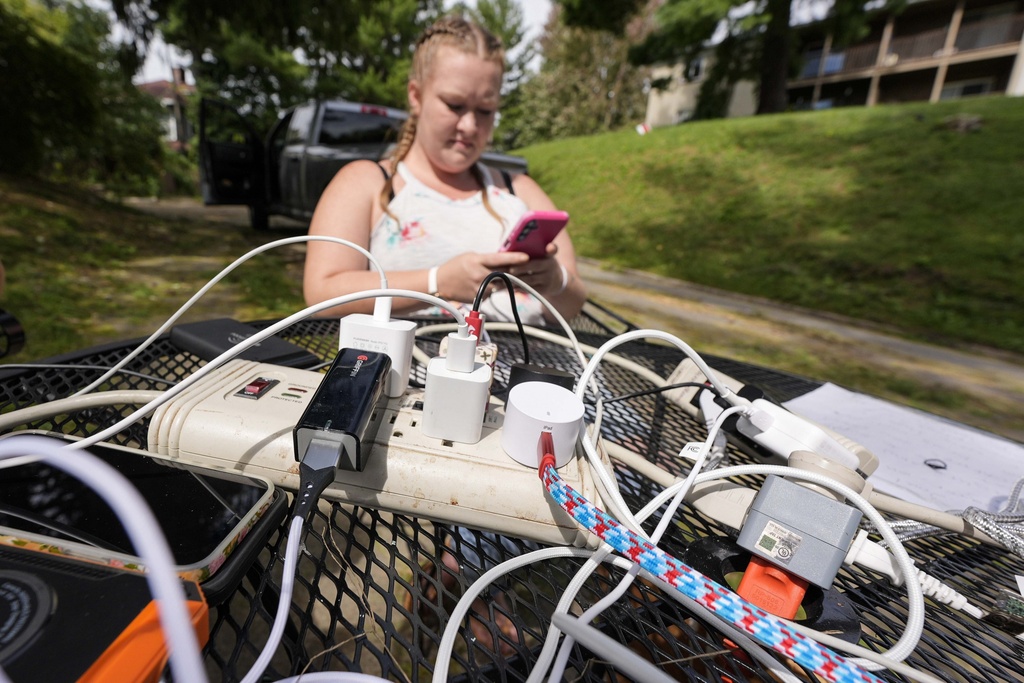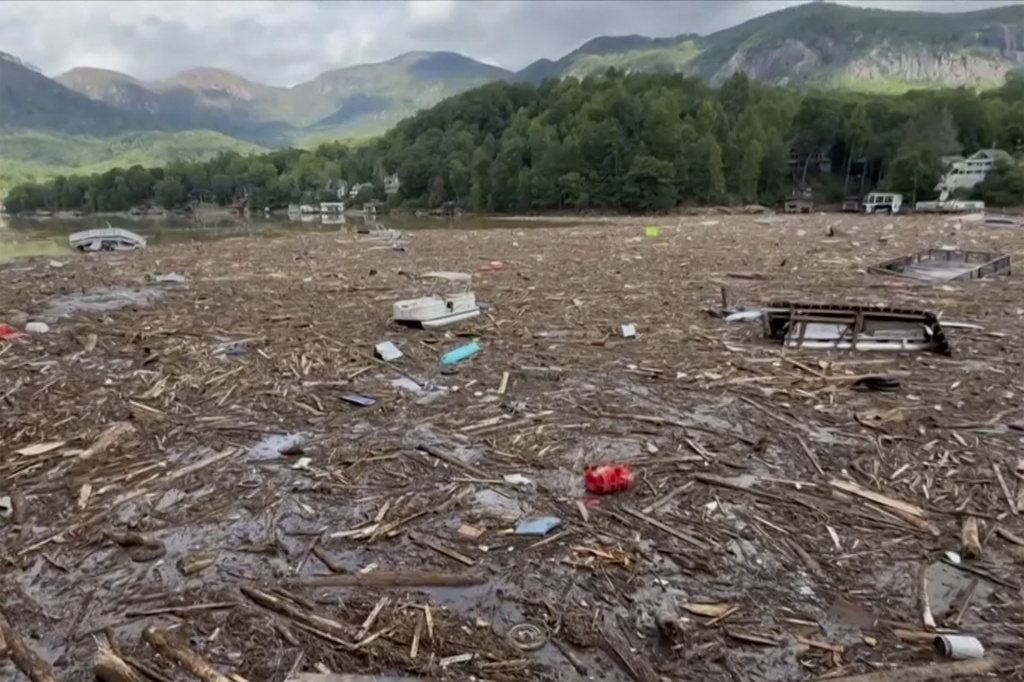Hurricane Helene Leaves Over 130 Dead Across the Southeast \ Newslooks \ Washington DC \ Mary Sidiqi \ Evening Edition \ Hurricane Helene left a trail of destruction across the Southeastern U.S., with over 130 lives lost and widespread devastation, especially in western North Carolina. In Asheville and surrounding areas, residents struggled without power, clean water, or communication, waiting for aid amid washed-out roads and collapsed infrastructure. Government officials, including President Joe Biden and North Carolina Governor Roy Cooper, have vowed continued support as relief efforts intensify.

Hurricane Helene: Widespread Devastation in the South Quick Looks
- Death Toll Exceeds 130: Hurricane Helene left over 130 dead across six Southeastern states, with North Carolina bearing the brunt.
- Western North Carolina in Crisis: Asheville and surrounding mountain towns are particularly hard-hit, with washed-out roads and no power.
- Relief Efforts Underway: Supplies are being delivered by truck, airlift, and even mule to isolated areas.
- Federal and State Responses: President Biden and North Carolina Governor Cooper are actively coordinating relief and surveying damage.
- Massive Flooding and Displacement: Thousands remain without homes or basic necessities as FEMA and volunteers work to provide aid.
Deep Look
Hurricane Helene, one of the most catastrophic storms in U.S. history, has devastated the Southeastern United States, leaving behind a scene of widespread destruction from Florida’s Gulf Coast to the Appalachian Mountains in Virginia. The death toll continued to rise Monday, reaching at least 133 people across six states, with particularly severe impacts on western North Carolina.
The crisis is particularly dire in Asheville, North Carolina, and the surrounding mountain towns, where roads have been washed away, and power and communication remain down. Stranded residents lined up for fresh water and the opportunity to contact loved ones, some for the first time since the storm, to let them know they were alive.
Crisis in Western North Carolina
The destruction in western North Carolina has been profound, especially in Asheville and its surrounding areas, which were directly in the storm’s path. More than 40 people lost their lives in Buncombe County, which includes Asheville. The mountainous terrain and already-saturated ground only worsened the impact, causing severe flooding, mudslides, and collapsed infrastructure. President Joe Biden, who has promised that the federal government will stand with the affected communities “as long as it takes,” plans to visit North Carolina on Wednesday to survey the damage and meet with local officials.
Images of the destruction depict a region struggling to cope: bridges covered in splintered debris, mud-caked highways, and uprooted homes. In Lake Lure, a normally picturesque site outside Asheville, overturned pontoon boats, broken docks, and debris were strewn across the water, while residents gathered on hillsides to send a simple message to their loved ones: “I’m OK.”
In one neighborhood, Sommerville Johnston spoke of resilience as she prepared to share what she could with her community. Without power since Friday, she planned to cook a venison stew from her freezer before it spoiled, telling her neighbors, “Just bring your bowl and spoon.” It’s this spirit of sharing and resilience that has helped many residents through the days of uncertainty and loss.
The Rising Death Toll
Tragic stories continue to emerge across North Carolina as emergency workers reach more isolated areas. Many deaths have been attributed to drowning, falling trees, and flash floods that overwhelmed homes and cars. Among the victims was a courthouse security officer who drowned after being submerged inside his truck, as well as a family—a couple and their young child—who died after their roof collapsed while waiting for rescue.
Despite these tragic losses, rescue efforts have also led to remarkable moments of survival. Dozens of people have been saved, including an infant and two others who were rescued from atop a car in Atlanta. In Tennessee, more than 50 hospital patients and staff members were airlifted to safety from a rooftop, showcasing the bravery and tireless work of first responders.
Federal Emergency Management Agency (FEMA) officials reported that shelters have provided refuge for over 1,000 displaced residents. FEMA Administrator Deanne Criswell surveyed the damage alongside North Carolina Governor Roy Cooper, who took an aerial tour of the Asheville area and later spoke with workers distributing meals to those in need.
“This has been an unprecedented storm that has hit western North Carolina,” Governor Cooper said. “It’s requiring an unprecedented response.” He implored travelers to avoid the area to allow emergency workers to focus on rescue and recovery operations.
Relief Efforts and Desperation
In the wake of Hurricane Helene, many communities are cut off, struggling to access basic necessities like water and food. With roads destroyed or blocked by landslides, including a four-mile stretch of Interstate 40, Asheville’s infrastructure has been severely compromised. The city’s water system has been so damaged that some residents are resorting to collecting creek water in buckets to flush their toilets.
In response to the mounting crisis, volunteers have stepped in to support the beleaguered communities. Mike Toberer brought a dozen of his mules to deliver food, water, and diapers to those who remain cut off by the storm. “We’ll take our chainsaws, and we’ll push those mules through,” he said, emphasizing the dire need for creative and determined solutions in the wake of such overwhelming destruction.
Others lined up at local suppliers, such as Mountain Valley Water, to fill up whatever containers they could find. Derek Farmer, who brought three gallon-sized apple juice containers, said he had been prepared for the storm, but after three days without water, anxiety had set in. “I just didn’t know how bad it was going to be,” Farmer said, highlighting the desperation faced by residents.
With temperatures dropping, many residents are also facing the cold without electricity or heating. Shelters have become overcrowded, and aid workers have warned that rebuilding and restoring normalcy will be a lengthy process. FEMA has mobilized ten federal search and rescue teams, with nine more on the way, and the agency has begun deploying trucks and cargo planes loaded with food and water to the hardest-hit regions.
Why Western North Carolina Was Hit Harder
The devastation in western North Carolina was exacerbated by several geographical and climatic factors. When the remnants of Hurricane Helene reached the region, they encountered the higher elevations and cooler air of the Appalachian Mountains, leading to increased rainfall that compounded the existing flood risk. This was worsened by the fact that the ground was already saturated from previous rains, creating conditions ripe for catastrophic flooding.
“Asheville and many surrounding mountain towns are built in valleys, leaving them especially vulnerable to devastating rain and flooding,” said Christiaan Patterson, a meteorologist with the National Weather Service. Patterson explained that climate change has made storms like Helene more frequent and intense, pointing out that rising ocean temperatures are causing storms to develop and strengthen rapidly—often within a matter of hours.
The storm delivered the worst flooding North Carolina has seen in a century, with some areas recording over two feet (61 centimeters) of rainfall since last Wednesday. The aftermath has left thousands of homes flooded or destroyed and many communities without power or access to clean drinking water.
Destruction from Florida to Virginia
The impact of Hurricane Helene was felt well beyond North Carolina. The storm first made landfall in northern Florida late Thursday as a Category 4 hurricane before sweeping through Georgia, the Carolinas, and Tennessee. Several feet of water inundated the Clearwater Marine Aquarium along Florida’s Gulf Coast, forcing workers to relocate two manatees and several sea turtles. Although the animals were safe, vital equipment at the facility was destroyed, according to aquarium director James Powell.
In Georgia, Governor Brian Kemp described the storm as one that “literally spared no one.” In Augusta, a city of about 200,000 near the South Carolina border, most people were still without power as of Monday. With at least 30 reported deaths, South Carolina faced its deadliest tropical cyclone since Hurricane Hugo struck in 1989, taking 35 lives.
Tropical Storm Kirk on the Horizon
As the Southeast grapples with the aftermath of Hurricane Helene, another storm has formed in the Atlantic. Tropical Storm Kirk, located about 800 miles (1,285 kilometers) west of the Cabo Verde Islands, is expected to intensify into a large and powerful hurricane by Tuesday night or Wednesday, according to the U.S. National Hurricane Center. While no coastal watches or warnings are currently in effect, the formation of Kirk serves as a sobering reminder of the ongoing hurricane season and the potential for further damage.
Hurricane Helene Leaves Hurricane Helene Leaves Hurricane Helene Leaves Hurricane Helene Leaves







